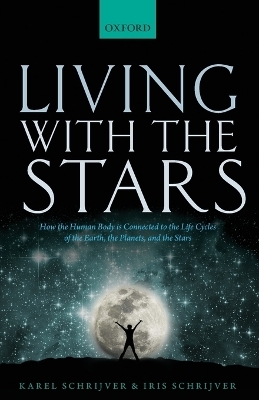
Living with the Stars
Oxford University Press (Verlag)
978-0-19-883591-2 (ISBN)
Living with the Stars tells the fascinating story of what truly makes the human body. The body that is with us all our lives is always changing. We are quite literally not who we were years, weeks, or even days ago: our cells die and are replaced by new ones at an astonishing pace. The entire body continually rebuilds itself, time and again, using the food and water that flow through us as fuel and as construction material. What persists over time is not fixed but merely a pattern in flux.
We rebuild using elements captured from our surroundings, and are thereby connected to animals and plants around us, and to the bacteria within us that help digest them, and to geological processes such as continental drift and volcanism here on Earth. We are also intimately linked to the Sun's nuclear furnace and to the solar wind, to collisions with asteroids and to the cycles of the birth of stars and their deaths in cataclysmic supernovae, and ultimately to the beginning of the universe. Our bodies are made of the burned out embers of stars that were released into the galaxy in massive explosions billions of years ago, mixed with atoms that formed only recently as ultrafast rays slammed into Earth's atmosphere. All of that is not just remote history but part of us now: our human body is inseparable from nature all around us and intertwined with the history of the universe.
Karel Schrijver is a Senior Fellow at Lockheed Martin's Advanced Technology Center in Palo Alto, California. He was trained as a stellar astrophysicist, but soon focused on the Sun as the one star that regulates life on Earth. His professional interests range from the magnetism in the solar interior and atmosphere to interplanetary space, to the environments of planets, and to the impacts of space weather on human technology. He has authored many research publications and several pieces for the general public, but this is the first book reaching beyond his daily work. He never tires from looking at the beautiful star that we live with, observed with instruments in space that capture the Sun's atmosphere in colors that cannot reach the unaided human eye. Iris Schrijver is a Professor of Pathology and Pediatrics at Stanford University School of Medicine. She is a physician with medical specialty training in both genetics and pathology, and she directs the Molecular Pathology laboratory at the Stanford Medical Center. This laboratory provides diagnostic testing for children and adults with inherited conditions and with cancers. Depending on the condition tested for, the testing helps to make a diagnosis, to establish the prognosis, to select the right treatment, and to monitor for recurrence of disease. Her research targets the causes of hereditary hearing loss and cystic fibrosis, and the development and application of optimal diagnostic methods. She has authored and edited original research articles, book chapters, and books. She is fascinated by all the connections between her world of DNA, Karel's universe, and the sheer multitude of links between them, so paramount to all aspects of life.
1: The Illusion of Permanence
2: Dying to Live
3: Countering Wear and Tear
4: Food for Thought
5: Basking in Solar Energy
6: The Human Elements
7: Cycles of Change
8: Infant Atoms
9: The Origin of Elements
10: Cosmic Rays and Galactic Ecology
11: Tails in the Wind
12: A Magnetic Heartbeat
13: Building a Home
14: Stardust in Flux
| Erscheinungsdatum | 17.01.2019 |
|---|---|
| Verlagsort | Oxford |
| Sprache | englisch |
| Maße | 138 x 215 mm |
| Gewicht | 284 g |
| Themenwelt | Kunst / Musik / Theater ► Allgemeines / Lexika |
| Sachbuch/Ratgeber ► Natur / Technik ► Weltraum / Astronomie | |
| Naturwissenschaften ► Physik / Astronomie | |
| ISBN-10 | 0-19-883591-4 / 0198835914 |
| ISBN-13 | 978-0-19-883591-2 / 9780198835912 |
| Zustand | Neuware |
| Haben Sie eine Frage zum Produkt? |
aus dem Bereich


